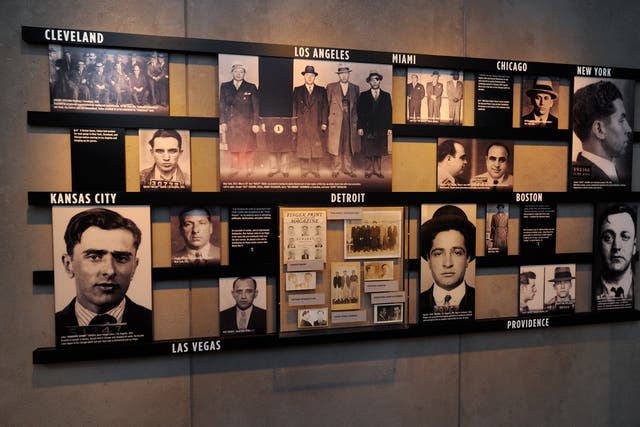

Based in Italy and the U.S., the Mafia is a network of organized-crime groups active in a range of underworld ventures, from drug trafficking to murder. The Mafia evolved over centuries in Sicily, an island off the southern tip of Italy that until 1861 was ruled by a line of foreign invaders. Sicilians banded into groups to protect themselves; by the 19th century, some of these groups emerged as private armies that extorted protection money from landowners and evolved into the criminal enterprise known today as the Sicilian Mafia. The American Mafia, a separate entity, rose to power in the Prohibition era of the 1920s and soon flourished. By the late 20th century, however, anti-racketeering laws and other techniques brought down high-ranking mobsters both in Italy and the United States. By the early 21st century, the Mafia had been weakened but it still has not been driven out of business.
By the later part of the 19th century in Sicily, Italy, criminal gangs who had become known as the Mafia flourished by using violence and intimidation to extract protection money from landowners and merchants. By the 1920s, the Sicilian Mafia was facing a challenge from Prime Minister Benito Mussolini (1883-1945), who came to power in 1922. Mussolini viewed the Mafia as a threat to his Fascist regime and launched a brutal crackdown in which more than a thousand suspected Mafiosi were convicted and thrown in prison. (Some Italian mobsters escaped to the United States, where they became involved in the bootleg liquor business and the burgeoning American Mafia.) Following World War II, the Mafia rose again as mob-backed building companies worked to dominate the 1950s construction boom in Sicily.
The new series, American Godfathers: The Five Families, premieres Sunday, August 11 at 8/7c and streams the next day.
In the early 1950s, Estes Kefauver (1903-1963), a U.S. senator from Tennessee, launched an investigation into organized crime and held televised public hearings that represented the first time any part of the federal government publicly recognized the existence of the American Mafia. However, citing a lack of specific evidence, the FBI and other law-enforcement agencies, along with Congress, failed to take any substantial action. Then, in 1957, police in the small upstate New York town of Apalachin raided a gathering of more than 60 mobsters from around the country. In the aftermath of the raid, the government could no longer ignore the Mafia’s existence or insist that Italian-American crime gangs operated only on a local level.
In the early 1960s, U.S. Attorney General Robert Kennedy (1925-1968) stepped up government efforts to fight organized crime and corruption in labor unions. One of Kennedy’s top targets was Jimmy Hoffa (1913-1975), the head of the million-plus-member Teamsters union. Kennedy also pressured FBI director J. Edgar Hoover, who had been slow to pursue the Mafia, to intensify his agency’s efforts against mobsters. The FBI, whose investigators up to that time had scant knowledge about the Mafia’s operations, began an electronic spying program that netted valuable information. Another important development came in 1963, when convicted New York mobster Joseph Valachi broke the Mafia’s sacred code of silence, or omerta, and became a government informant, revealing and confirming details about the Mafia’s structure and customs for the first time.
Starting in the later part of the 20th century, the government began winning its war against the Mafia. In 1970, Congress passed the Racketeer Influenced and Corrupt Organizations (RICO) Act, which proved to be one of the most powerful tools used to take down mobsters, as it allowed the government to “attack criminal enterprises on a broad front, stripping them of their leadership and sources of both illicit and legitimate revenue in one massive prosecution,” according to a 1992 report in Congressional Quarterly.
During the 1980s and 1990s, RICO laws were used to convict high-ranking mobsters, who in the past had been able to avoid prosecution. (Similar laws were effective in producing mass convictions in Italy during this time.) Some Mafiosi, faced with long prison sentences, opted to testify against fellow mobsters in exchange for a place in the witness-protection program. Additionally, Mafia membership in the U.S. declined as insular Italian-American neighborhoods, once a traditional recruiting ground for mobsters, underwent demographic shifts and became more assimilated into society.
By the early 21st century, the American Mafia was a shadow of its former self and the FBI had begun cutting resources devoted to investigating organized crime. While crime families in New York and Chicago, the longstanding centers of Mafia activity, had been battered but not driven out of business, many crime clans around the rest of the U.S. were in disarray or on the verge of extinction, according to New York Times journalist and organized crime researcher Selwyn Raab.
In Italy, law-enforcement agencies continued to make progress against organized crime as well. However, the Mafia remains active there and in the United States, where it continues to be involved in some of its traditional activities, including loan-sharking and illegal gambling. At the same time, its hold on labor unions and industries such as construction has been weakened but not eliminated. Contributing to the Mafia’s ongoing survival may be the fact that following the September 11, 2001, terrorist attacks on America, significant organized-crime resources were shifted to counter-terrorism work.
From law and order in ancient Rome to contemporary drug kingpins, stream hours of crime history documentaries in HISTORY Vault.